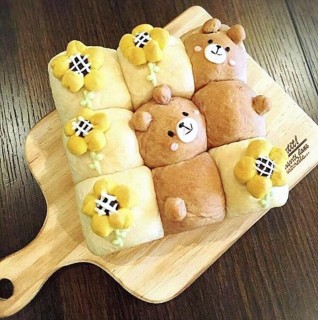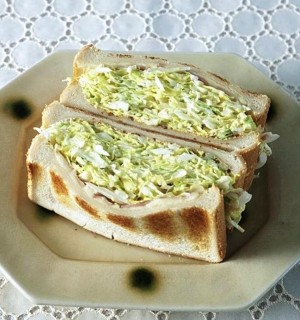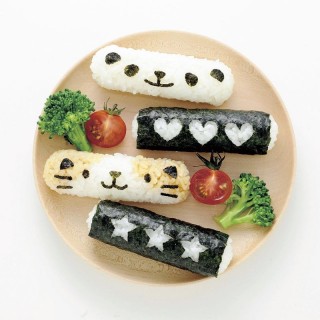Loading
Search
▼ Original Recipes Go Viral On Social M
- Category:Gourmet
The internet is changing the way people cook. Some simple recipes posted online have become viral hits, leading to the publication of cookbooks and even the development of a special kitchen tool. With creative ideas and photo techniques, original recipes could also become a new trend as they are shared through social networking sites.
Response on Instagram
Online photo-sharing sites can often encourage creativity. A good example is chigiri pan, homemade bread baked in small portions and decorated as cute characters and animals. A search for “chigiri pan” on photo-sharing site Instagram brings up more than 90,000 photos. The name chigiri pan (literally, pieces of bread that can be torn up) refers to how people eat it by tearing off bite-sized chunks.
To try her hand at baking it for her 1-year-old son Shu last year, Madoka Funaki of Shinjuku Ward, Tokyo, first searched for photos on Instagram. She found a wide variety of photos from bread colored with cocoa, vegetable powder and other ingredients to bread decorated with chocolate eyes and mouths to give it the appearance of special characters.
Funaki posted a photo of her first chigiri pan effort on Instagram and it drew comments such as “How cute,” and “Cool,” from people she has never met.
“After receiving so many responses, I now enjoy thinking about what kind of bread I can bake next time,” she said.
Cabbage sandwich
Potter Michiyuki Onuma never expected his original recipe to become so popular, especially with part of his name attached to it.
Since he was young and single, Onuma, now married and in his 50s, always made a sandwich featuring shredded cabbage dressed with mayonnaise for breakfast.
“It’s easy to prepare and eat, and helped me get my vegetables,” he said, referring to a class of ingredients many young people try to avoid.
Last year, his wife, Yuki, posted the recipe on Instagram at the request of a friend. She called it “Numa-san,” an abbreviated form of “Onuma’s sandwich.” The sandwich soon became a hit with many people describing it as “easy to make” and “tasty.”
Currently more than 30,000 photos of sandwiches with eggs, tomatoes and some other ingredients based on the original Numa-san sandwich can be found online. Its popularity eventually led to the publication of the cookbook “Numa-san” by Takarajimasha, Inc., priced at ¥980 plus tax.
“I’m astonished that our regular family breakfast has spread so fast,” Yuki said.
Another recipe quickly gaining popularity on social media is “gyugyuyaki,” a baked dish created by translator Riko Murai.
Murai tweeted her original recipe of putting a selection of vegetables, meat and fish on a tray, sprinkling it with olive oil and salt and putting the tray into the oven.
“I don’t like the hassle of cooking, so I looked to keep things simple and make it tasty. I came up with this recipe through trial and error,” Murai said.
The ingredients are savory and look colorful and can be served on one plate, so there is not much to clean up afterward. In December, the cookbook “Muraisanchi no Gyugyuyaki” featuring her recipes was published by Kadokawa Corp. for ¥1,000 plus tax.
‘Stick onigiri’ rice rolls
Social media posts can also lead to product development. The onigirazu rice sandwich has been invented as a new wave version of onigiri rice balls. The latest incarnation of onigiri, “stick onigiri” rice rolls, are now trending, and many photos of them can be found online.
They can be made by putting a filling on a layer of rice and using plastic wrap to shape the rice into a stick like a piece of candy.
When Yukako Sekine, an employee of household goods company Arnest Inc., found it hard to shape the rice into the stick shape, the company developed a tool to do this. The tool Deco Stick Onigiri Set, which comes with a stick mold for rice and nori seaweed punch cutters, is available for ¥1,296.
Last year, his wife, Yuki, posted the recipe on Instagram at the request of a friend. She called it “Numa-san,” an abbreviated form of “Onuma’s sandwich.” The sandwich soon became a hit with many people describing it as “easy to make” and “tasty.”
Currently more than 30,000 photos of sandwiches with eggs, tomatoes and some other ingredients based on the original Numa-san sandwich can be found online. Its popularity eventually led to the publication of the cookbook “Numa-san” by Takarajimasha, Inc., priced at ¥980 plus tax.
“I’m astonished that our regular family breakfast has spread so fast,” Yuki said.
Another recipe quickly gaining popularity on social media is “gyugyuyaki,” a baked dish created by translator Riko Murai.
Murai tweeted her original recipe of putting a selection of vegetables, meat and fish on a tray, sprinkling it with olive oil and salt and putting the tray into the oven.
“I don’t like the hassle of cooking, so I looked to keep things simple and make it tasty. I came up with this recipe through trial and error,” Murai said.
The ingredients are savory and look colorful and can be served on one plate, so there is not much to clean up afterward. In December, the cookbook “Muraisanchi no Gyugyuyaki” featuring her recipes was published by Kadokawa Corp. for ¥1,000 plus tax.
‘Stick onigiri’ rice rolls
Social media posts can also lead to product development. The onigirazu rice sandwich has been invented as a new wave version of onigiri rice balls. The latest incarnation of onigiri, “stick onigiri” rice rolls, are now trending, and many photos of them can be found online.
They can be made by putting a filling on a layer of rice and using plastic wrap to shape the rice into a stick like a piece of candy.
When Yukako Sekine, an employee of household goods company Arnest Inc., found it hard to shape the rice into the stick shape, the company developed a tool to do this. The tool Deco Stick Onigiri Set, which comes with a stick mold for rice and nori seaweed punch cutters, is available for ¥1,296.
“Our product is designed to make small stick-shaped rice balls that children find easy to eat because their mouths are small,” Sekine said.
Food presentation popular
On social media sites, layout and presentation of the food also draw attention. One-plate meals using washoku cuisine are one example.
In this style, typical dishes of Japanese-style meals — rice, soup, a nimono simmered dish and grilled food among others — are served on one plate.
On its website, Kikkoman Corp. introduces recipes and presentation techniques using this style. A plate about 25 centimeters in diameter is ideal for one person, according to Koichiro Oka, a Kikkoman employee in charge of the recipes.
“Make sure there is space between items, and use shiso or bamboo leaves as decoration to make the plate look nicer,” Oka said.
Food presentation popular
On social media sites, layout and presentation of the food also draw attention. One-plate meals using washoku cuisine are one example.
In this style, typical dishes of Japanese-style meals — rice, soup, a nimono simmered dish and grilled food among others — are served on one plate.
On its website, Kikkoman Corp. introduces recipes and presentation techniques using this style. A plate about 25 centimeters in diameter is ideal for one person, according to Koichiro Oka, a Kikkoman employee in charge of the recipes.
“Make sure there is space between items, and use shiso or bamboo leaves as decoration to make the plate look nicer,” Oka said.
- October 1, 2016
- Comment (0)
- Trackback(0)




